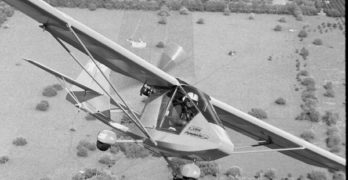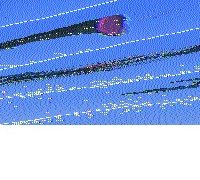In a flying world that seems to think a 2-seater is mandatory, Mark Beierle has released another single-place ultralight. And what a sweet ultralight it is.
I love the Thunder Gull series of ultralights. When people ask me what I personally like of the hundreds of ultralights evaluated, the Thunder Gull always springs to mind (among a few other designs). My interests may not be your interests, but I’ll bet most pilots would love to fly the Gull 2000.
Offered for sale here in the new millennium, the Gull 2000 is an appropriate name that seemed well aimed at lots of American ultralight enthusiasts.
Welcome to Gull 2000
For the new century, the Gull 2000 adds to, rather than replaces the older models from Earthstar Aircraft. The company will still sell their Thunder Gull J single-seater and their little-publicized Soaring Gull, which uses a very small engine and long wings to create something of a motorglider.
Search Results for : Flight Design
Not finding exactly what you expected? Try our advanced search option.
Select a manufacturer to go straight to all our content about that manufacturer.
Select an aircraft model to go straight to all our content about that model.
Dope and Fabric Hawk Arrow
One of the ultralight industry’s longest enduring designs is the Hawk. First offered in 1982, the Hawk flies today – 15 years later! – in essentially the same form. A few years ago the Arrow name was added to a refined version (becoming the Hawk Arrow) but the basics didn’t change. The original became the Hawk Classic.
So, why are we reporting on it? Two reasons quickly spring to mind.
First, the plane deserves it. This is an excellent little bird that has delivered a lot of aerial fun to virtually a generation of pilots. However, new pilots enter the community between articles and these aviators need to know this design still works well today like it did way back in the early ’80s when ultralights were new on the aviation scene.
Secondly, this isn’t the same Hawk.
Oh, it still looks much the same. Such a statement is hardly fair, though, to the many refinements that showed up on the plane I flew for this report.
Powrachute
Like a poised cat, restrained energy waiting for its opportunity, Powrachute sprang into the powered parachute industry and snapped up a share of this fast-growing aviation segment. In just a couple of years, the Kansas company has found some 300 buyers of their distinct ultralight.
Given their approach to the industry, perhaps using a “spokes tiger” is highly appropriate. A feline named Noah is featured in the company’s ads and on its brochure. As with the unusual spelling of the corporate name, Noah helps Powrachute stand out in a crowd. (Personally, I thought the letters meant Pow’r-a-‘chute, spelled in the shorthand way of vanity license plates.)
Until recently, the Kansas company offered a single 2-seat model – the PC2000 – which could be configured with various options. The PC2000 is a new design “for the 21st century.” However, despite its newness, even the PC2000 changed rather dramatically to add rollover protection which the company calls Frontal Fuselage Bars.
Rocky Mountain Wings Ridge Runner
One of the all-time successes in the world of kit-built light aircraft is the Kitfox. Challenged in terms of success by Vans Aircraft’s RV series, many Kitfox aircraft have been sold. Denney Aerocraft, the original manufacturer of the Kitfox design, never considered a single-place machine. Why would they? Even pumping out 60 planes a month in their heyday of the early 1990s, they were barely keeping up production quotas.
Avid Aircraft, producer of the Avid Flyer (the forerunner of the Kitfox) also never pursued a single-place model. In the early 1990s Avid was also going strong. But by early 2000, things looked a bit different.
Dan Denney sold Denney Aerocraft to Phil Reid in the early 1990s, and the company was renamed SkyStar Aircraft. The company was then sold again to Ed Downs and partners, with the company name remaining SkyStar Aircraft. By this time, the Kitfox design became somewhat saturated, and other creations muscled into the limelight of pilot attention.
Aero-Lite 103
Manufacturers in the ultralight industry believe they know what pilots want or what they will buy, anyway. A 2-seater is usually part of the answer. But, in fact, many industry watchers are wrong.
While many observers make the statement, ÒNinety percent of ultralights are 2-seaters,Ó statistics tell another story. Nearly 40% of ultralight and microlight aircraft sold in the U.S. are single-seaters, according to Ultralight Flying! magazineÕs surveys of manufacturers. Despite the polling results, however, those experts have a point. Two-seaters do represent the majority of ultralights and microlights sold.
Yet, just when you think 2-seaters are going to take over the whole market, along comes a new trend. Maybe it was FAAÕs lack of action on Part 103 changes, or maybe manufacturers simply decided to take on the challenge of staying within 103Õs tight weight, speed and fuel quantity restrictions. Whatever the correct answer, it doesnÕt change the fact of a growing population of Part 103 ultralights.
Titan Tornado
An Experimental ‘fighter jet’ that any pilot could love That vast majority of general aviation pilots who won’t even think about building their own plane has missed quite a revolution.
The FAA says approximately 25,000 aircraft are registered as Experimentals. That’s 15% of the GA fleet.
Building isn’t what it used to be. You no longer need to master the skill of reading engineering prints (plans), nor must you search high and low for parts.
These days, most registered Experimental aircraft are built from kits. Many are well-fabricated packages that can be assembled in just a few hundred hours. That can mean as little as two or three hours a night, two to three days a week, for about a half-year. Not a bad investment for a truly unique airplane.
One sport pilot who enjoys flying his creations is Minnesota resident Al Reay. For Reay, building is a means to an end.
Super Magnum
The Super Magnum packs an 80-horse four-stroke Verner Some general aviation pilots are put off by ultralights; for others they’re great fun.
If you’re the type who likes the idea of ultralight flight but you don’t trust the common two-stroke engines, then Sport Flight’s Super Magnum kit-built aircraft with the Verner engine may be what you’re looking for.
JOIN THE FAMILY
For nearly a decade, Sport Flight Aviation has produced the Talon XP two-seater and the Magnum single-seater. In 1998 the company added the Super Magnum, a one-place airplane that features a substantial 80-horsepower engine from the Czech Republic.
The Verner SVS-1400 engine was brought to the United States by Milan Stavenik in the mid-1990s. Milan lost his life in an accident unrelated to the Verner, but development of the engine has continued under Sport Flight Aviation owner Roger Bitton.
In addition to the Verner, the new HKS 700E, imported from Japan by Hpower, is enjoying a good reception.
Laminar MR 2000
You can’t argue with success. And if you do, hundreds of Icaro Laminar pilots will come out and shut you up by showing you the top of the thermal. Certainly we all know that the Laminar has shown its formidable capabilities under the guidance of Manfred Ruhmer. But what about the average pilot like you and me? Do we have a defensible position?
Come along as we review the new Laminar MR 2000 and see where things stand. You’ll discover some improvements over a glider that was already pretty good (the Laminar ST). You’ll also see what makes this glider work as we catalog its high and low points. In the past few years Icaro has written the rules on handling and performance, so let’s see how they have progressed.
LAMINAR GENERAL
My flying on the MR 2000 consisted of a fun flight from Wallaby to Quest Air as a warm-up for the second Florida meet this year.
Convertible Buckeye
In a calculated move planned for over a year, powered parachute leader Buckeye Industries introduced their new trike line at AirVenture ’98. This marks two points of interest to EXPERIMENTER readers.
The first point is a significant entry to the trike market, a segment of ultralight aircraft that has finally shown real growth potential after many years of effort by trike makers. Though European companies threw open the door with persistent marketing efforts mimicked by a few Yankee builders, Buckeye’s entry to the field could increase the number of trikes sold by a good margin.
Secondly, as a widely acknowledged sales leader among powered parachute builders, Buckeye is making something of a statement to that community of aviation enthusiasts. Powered parachutes deserve a follow-on aircraft and Buckeye has decided (logically, to my view) to make that successor a trike.
And, Why Not?
If you owned Buckeye and already made a slick, wheeled carriage for your powered parachutes, wouldn’t you also leverage that design to work for a trike?
The Appeal of Trikes
Trikes: they’re enjoyed around the world by thousands of pilots A what?
Not sure what a “trike” is, are you? Don’t feel bad. Although these machines may represent the largest production of aircraft in the world, many pilots have overlooked their appeal.
A trike is an aircraft made of two principle parts: a wing that resembles a hang glider (but is more stoutly built) and a carriage. The latter element is comprised of an engine, landing gear, seat and instrumentation. Within certain bounds, the wings and carriage can be mixed and matched.
They may sound strange, but they are enjoyed around the world by thousands of pilots. In fact, among European light aviation enthusiasts, about one in every two flies a trike.
Just a toy? Not!
In case you think that such a contraption must be only for young sport enthusiasts that don’t have enough money for a “real” airplane, think again.









